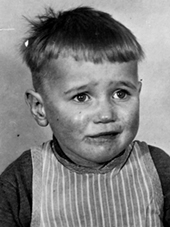Search for Names, Places and Biographies
Already layed Stumbling Stones
Suche
Manfred Bala * 1939
Amelungstraße 4 (Hamburg-Mitte, Neustadt)
HIER WOHNTE
MANFRED BALA
JG. 1939
DEPORTIERT 1943
’HEILANSTALT’
KALMENHOF
ERMORDET 11.11.1943
further stumbling stones in Amelungstraße 4:
Harriet Elias
Manfred Bala, b. 12.27.1939 in Hamburg, committed to the then Alsterdorf Institute on 1.18.1943, transferred on 8.7.1943 to the Kalmenhof Psychiatric Hospital at Idstein, murdered 11.11.1943
Amelungstraße 4 (Amelungstraße 6)
When Manfred Bala was born on 27 December 1939 in the Women’s‘ Clinic in Altona, his mother Edith Gertrud Bala (b. 4.2.1917) was in difficult financial circumstances. She struggled to make a living as household help and as a worker; at the time of her pregnancy she was unemployed. Edith was the illegitimate child of Erna Fehn, née Bala (b. 12.27.1886 in Mołodycz) and the riveter, Theodor Kostka (b. 12.21.1888 in Körnitz); she grew up in the Gängeviertel of the New City at Amidammachergang 10. In 1921, her mother had married the dock worker Peter Fehn (b. 8.4.1880 in Rottelsdorf), shortly before Edith’s half sister Maria was born.
Edith initially attended a Catholic school and then lived for a time in the orphanage on Averhofstrasse, because Erna Fehn, suffering from a neurological disease, was no longer up to the task of caring for her. After her mother’s death on 1 April 1938, Edith Bala lived as a sub-lessee with Ösinghaus in a sparsely furnished room at Amelungstrasse 6. Because she had a bed neither for herself nor for Manfred, he was brought to various children’s homes. His father’s identity has not been preserved.
In July 1941, Manfred was released again to the care of his mother, until the Youth Office withdrew custody in 1942 on the grounds of "complete neglect” of the child. Manfred was placed under guardianship and went into the Johannes Petersen Home in Volksdorf (founded in 1906 by the Masonic Pestalozzi Foundation). Soon after his arrival, his teacher, Leni Maack, searched for his transfer to a "suitable environment.” In her view Manfred was a "feeble-minded” child and a burden to the group sense of community. She described him as completely helpless, erratic, unpredictable and difficult to control. On 20 October 1942, Manfred came down with scarlet fever and was committed to St. Georg Hospital. After her examination, Dr. Puls judged: "does not make an unintelligent impression, alternately laughs and weeps, will not let himself be comforted. Otherwise happy, calm, extremely mentally underdeveloped for his age.”
On 18 January 1943, the three-year old Manfred, "unclean” and with torn clothing, was sent from the Johannes Petersen Home to the then Alsterdorf Institute (today, the Alsterdorf Evangelical Foundation). He did not yet speak, but had already learned to run.
However, at Alsterdorf, too, Manfred Bala had little time to orient himself. Seven months later, on 7 August, he was among the boys between two and twelve years old, who were sent to Kalmenhof at Idstein im Taunus (under the pretext that the Allied air raids of 13 July had so damaged the institution that they could not be cared for there). Transport was by the "Public Utility Transport Company, L.L.C.” Gekrat for short. Those selected were labeled, in Institutional jargon, "patients of low-standing.”
The "Calmenhof Institute for Idiots" had been founded in 1888 as a charitable establishment by wealthy Christian and Jewish citizens of Frankfurt and Wiesbaden. In this originally progressive pedagogical institution, children with learning disabilities received schooling and professional training. In the 1920s, the Institute was renamed "Kalmenhof Institute for Curative Education.”
During the Third Reich, Kalmenhof was drawn into the first phase of the "Euthanasia” program, the so-called Action T-4, a camouflage description derived from the address of the Berlin central office at Tiergartenstrasse 4. Patients of both sexes were fed into Hadamar, the neighboring killing facility. After the official halt to the program in August 1941, in the second decentralized phase, the responsible physicians of the institution decided the deaths of handicapped children, teenagers, and adults.
"Now death rules in Kalmenhof.” That is the way the Idstein minister Boecker, a member of the Confessing Church, described the conditions there in 1942, when he was called upon to officiate at burials in the institution’s cemetery. In late 1941, the "Special Children Department” served the purpose of killing by medication or neglect. The selections of children were performed during the rounds by the Institute Director Wilhelm Grossmann and Dr. Mathilde Weber. Thirty-two of the Alsterdorf children went immediately upon arrival to the "Special Children Department.” Manfred Bala was among the remaining 20 children who initially were sent to another department in the institution. However, they also could not escape their fate. Manfred Bala, not yet four years old, died on 11 November 1943 at Kalmenhof. On the same day, little Klaus-Dieter Braasch (see his biographical sketch) was also condemned to die. Of the 52 children from the Alsterdorf Institute, only a single child lived to see the end of the war.
Translator: Richard Levy
Kindly supported by the Hermann Reemtsma Stiftung, Hamburg.
Stand: April 2020
© Susanne Rosendahl
Quellen: StaH 332-5 Standesämter 7204 u 357/1938; StaH 332-5 Standesämter 3398 u 1/1921; StaH 24-111 Amstgericht Altona 8297 (Vormundschaftswesen); Archiv der Evangelischen Stiftung Alsterdorf V40 Manfred Bala; Wunder: Exodus, S. 189–195.


